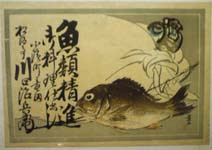:::::::::::::::::::::::::::::::::::::::::::::::::::::::::::::::::::::::::::::::::::::::::::::::::::::
Advertising circulars, hikifuda 引札
These are the early forms of public advertisements, many of them handed to the customers in front of the shop or store.
:::::::::::::::::::::::::::::::::::::::::::::::::::::::::::::::::::::::::::::::::::::::::::::::::::
Ebisu Daikoku Daruma
えびす大黒だるま
信濃大町 扇屋商店
from the early Meiji period


And one more with a lobster

Photos from my friend Ishino.
:::::::::::::::::::::::::::::::::::::::::::::::::::::::::::::::::::::::::::::::::::::::::::::::::::::
quote:
Heaps of Fun with Hikifuda
by Peter Ujlaki
Rooting through stacks of old prints for items to form the basis of a unique, low-budget collection, more and more recession-hit Japanese are turning to the late 19th century advertising circulars. Called hikifuda, many of these full-size sheets are signed by known artists (the ukiyo-e world being in serious decline at the time) yet rarely cost as much as US$100 for a good example in perfect condition.
A collector gets an evocative graphic, sometimes lavishly printed, that conveys a feeling for the new, unfettered commercial exuberance of the Meiji era, plus the name and location, writ large, of a specific (and perhaps still existing) family business.
 Examples of plugs for a particular restaurant or face powder can be found in standard Edo era prints, but it was too expensive, and probably meaningless, for an individual entrepreneur to commission a unique woodblock artwork to promote his firm. With the growth of urban center and all manner and new businesses, however, came a greater incentive to advertise, and along with that appeared the cost-cutting idea of many shopkeepers sharing a single ready-made design.
Examples of plugs for a particular restaurant or face powder can be found in standard Edo era prints, but it was too expensive, and probably meaningless, for an individual entrepreneur to commission a unique woodblock artwork to promote his firm. With the growth of urban center and all manner and new businesses, however, came a greater incentive to advertise, and along with that appeared the cost-cutting idea of many shopkeepers sharing a single ready-made design.Typically, merchants favored designs that were essentially elaborate, eye-catching borders. This left ample space for the name, description and location of the business. At times, however, they allowed the artist's work to run over most of the page, perhaps hoping customers would appreciate the added beauty.
Shopkeepers had a large variety of borders to choose from - immensely popular were the 7 Lucky Gods, ancient symbols, auspicious creatures, images that conveyed Japan's new "internationalism", and of course beautiful women - and new variations of these feel-good themes were added every year.
Curiously, today antiquarian stalls have numerous sheets with the message area left vacant. This suggests that salesmen must have scurried around town with "stock books" of blank samples for store owners to peruse.
Early hikifuda were executed by the laborious technique of woodblock cutting. This eventually gave way at the close of the century to lithography or combinations of Western techniques - not those treasured today - but the cost was still far from negligible.
Instead of ordering thousands of copies of the ad and sticking one into every gateway in town, merchants handed the beautiful sheets only to valued customers and neighborhood leaders. These folk, in turn, were counted on to disseminate the information by word of mouth. Due to such thrift, collectors may encounter the same border design more than once, but rarely the same design/text combination.
For a Westerner, the basic design of a hikifuda is likely of paramount importance, but in the domestic market - where the text is more or less understandable - desirability often derives from the name or type of shop, plus its location.
More is here
© www.artelino.com / Peter Ujlaki
Reprint from the
Daruma Magazine No. 26
:::::::::::::::::::::::::::::::::::::::::::::::::::::::::::::::::::::::::::::::::::::::::::::::::::

明治の引札 ... 田村コレクション
高田 功, 永野 一晃
ISBN-13: 978-4879405036
:::::::::::::::::::::::::::::::::::::::::::::::::::::::::::::::::::::::::::::::::::::::::::::::::::
Hikifuda from Sanuki
Collection of Fujii San

讃岐の引き札 ... 藤井コレクション
with English Information and more photos
© www.netwave.or.jp .. su-san
:::::::::::::::::::::::::::::::::::::::::::::::::::::::::::::::::::::::::::::::::::::::::::::::::::


Click for more photos !
Japanese LINK
. . . . . 幕末明治のメディア展
:::::::::::::::::::::::::::::::::::::::::::::::::::::::::::::::::::::::::::::::::::::::::::::::::::::::

keibutsubon 景物本
books published at the opening of a new store or for a special sale to bring customers to the shop.
振式亭福ばなし by Kosanba 小三馬 - 1835
LOOK at ten samples of these books:
source : salon/collection/premium
Origin of multi-color printing
景物本とは商店の開店祝いとか大売り出しのとき、顧客に配る宣伝パンフレットのことである。
- source : www.tvz.com/nishiki-e/nishiki1
江戸の情報文化 - advertisements in Edo
- source : teachme.jp/contents
:::::::::::::::::::::::::::::::::::::::::::::::::::::::::::::::::::::::::::::::::::::::::::::::::::
Kanban 看板 <> Shop Sign
BACK TO Daruma Museum
:::::::::::::::::::::::::::::::::::::::::::::::::::::::::::::::::::::::::::::::::::::::::::::::::::::










No comments:
Post a Comment